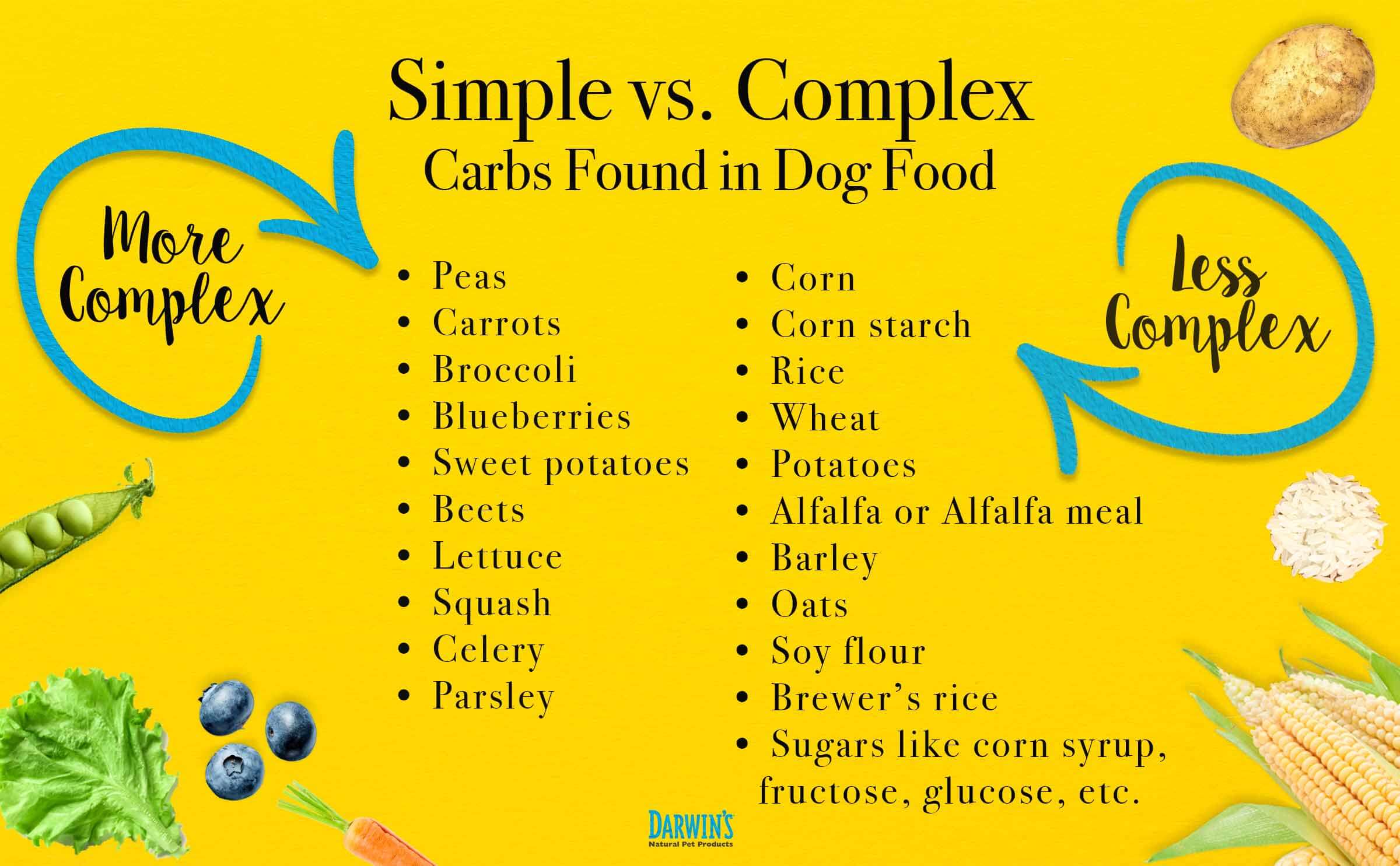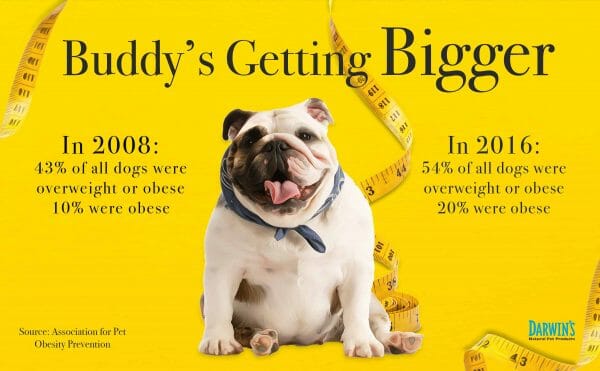Low-Carb Dog Food
3/8/18

Last Updated on
Inside This Article
- What Is Low Carbohydrate Dog Food?
- Are Carbs Good For Dogs?
- Benefits of Low-Carb Dog Food
- How to Transition Your Dog to a Low-Carb Diet
Low-Carb Dog Food: What Every Pet Owner Needs to Know
What’s an optimal diet for a dog? Well, that depends on the dog and on the food. Many dog owners are interested in feeding their dogs a low-carbohydrate (aka low-carb) diet. Some of this interest mirrors the trend of people who follow a low-carb or paleo diet, which includes lots of protein as well as fruits and vegetables. So more and more pet owners are researching and trying low-carb dog foods.
In many ways, this trend can be good news for dogs in U.S. Dog obesity has skyrocketed in the last decade, and many people think that the proportionally higher percentage of carbohydrates in commercial dog food are at least partially to blame. So anything that will help a dog get to and maintain a healthy weight has many positives.
Also, dogs are close relatives of wolves, who survived in the wild by eating bison, deer, and salmon. Using that thinking should dogs follow a wolf’s diet? The truth is dogs likely don’t need as many carbohydrates as they currently receive in their diets.
This article will define low-carbohydrate dog food and explore the typical range of carb content in commercial dog food. It will also explore the differences between simple and complex carbs, and how a dog digests them. We’ll examine the issues with grains found in dog food, and help dog owners learn how to read a dog food label and calculate the percentage of carbohydrates in their food.
Definitions: What Is Low-Carbohydrate Dog Food?
Every type of commercially prepared dog food contains three basic ingredients: protein, fat, and carbohydrate. Commercial dog food may also contain added vitamins and nutrients, and a substance called ash, which is a byproduct of the production process.
Many people are surprised to learn that dog food contains carbohydrates at all, believing that dogs are true carnivores and should eat mostly protein, with some fat. But dogs are actually omnivores and can eat a fair amount of carbohydrates (unlike cats, who are much more carnivorous than dogs are) because a dog’s digestive system accommodates a “scavenger” diet. Wild dogs and wolves eat berries, tubers, apples, and other wild fruits and vegetables, along with less savory ingredients like poop.
And dogs need some carbohydrates in their diets for both energy and digestion (fiber). Still, there is a growing concern that commercial dog food may contain a higher-than-necessary percentage of carbohydrates. According to the Merck Manual and the Association of American Feed Control Officials (AAFCO), optimal dog food contains a minimum of 18-25 percent protein and about 15 percent fat for skin and coat health. But the percentage of carb content in many commercial dog foods can range from 30 to as much as 70 percent. Most vets believe that much of those carbohydrates don’t give dogs the proper nutrition and contributes to canine obesity, which we will discuss later in this article.
Low-carb dog food has less than 30 percent carbohydrate content, and can even contain as low as 5-15 percent carbs. Conversely, high-carb dog food can contain as much as 70 percent carbohydrates, which likely means the dog is not getting enough quality protein in its diet.
As you look at your dog’s diet to determine its carb content, you should also be on the lookout for simple vs. complex carbs. For example, dogs truly do not need any grains, like rice, wheat, corn, etc. Potatoes come a close second to grains in the simple carbs category and provide minimal nutrition to dogs. Complex carbohydrates, on the other hand, include fruits and vegetables that may contain starches (like sweet potatoes or yams) but which also contain top nutrients like beta-carotene and vitamins. Complex carbs also include a range of vegetables and fruits like blueberries, cranberries, lettuces, celery, carrots, and more. Foods containing the latter provide more beneficial nutrition for your dog than those heavy on the simple carbs, especially grains, which have no nutritional benefit for dogs.

Why Commercial Brands Don’t Tend to Offer Low-Carb Dog Food Options
There are lots of reasons why the amount of carbs in dog food has become so widespread. Here are a few of them:
- Carbs are cheap to produce, especially grains and grain-production byproducts, which means a lower cost for the consumer.
- AAFCO, which works with federal and state agencies to oversee quality and standards for pet food, does not provide any limits on how much of a dog food may be comprised of grains and carbs.
- Carbs have a long shelf life and don’t go bad quickly.
- Carbs are essential for creating dry/kibble dog food to make the little kibble shapes.
- Dog food manufacturers aren’t required to list the percentage of carbohydrates, so most owners don’t even know how much they are feeding their dogs.
Are Carbs Good for Dogs?
The wildly varying amounts of carbohydrates in commercial dog foods, and the fact that there’s no official recommendation or guideline around how many carbohydrates food can contain means that dog owners need to be savvy. Dogs can and do eat carbs. Even wolves and coyotes, touted in many current commercials as having the ideal diets that domesticated dogs should also follow, are scavengers and eat fruit, tubers, and vegetables as well as meat, fish, eggs, and the like.
A diet too dense with protein can harm a dog’s digestive system and kidneys. So high-quality fats and nutritionally dense carbohydrates are part of a well-balanced dog diet. Optimal dog health will result from lower-carb foods and recipes, relative to the quantity of protein and high-quality fats in the food. If there are too many carbs in a dog food, dogs won’t be able to burn off those calories; lower quality carbs like grains and grain byproducts tend to be stored as fat.
In general, there are types of carbohydrates in commercial dog food that are less nutritious and count as either empty calories compared to other, more nutrient-dense carbs. When you read your dog food label, watch for these ingredients:
- Grains (corn, wheat and rice): These carbs are plentiful in the U.S. food supply, but are not typical of a dog’s omnivorous diet. Therefore grains can be hard for dogs to digest, and are often stored as fat.
- Alfalfa meal (hay): Alfalfa meal is found in many commercial dog foods because it’s plentiful and cheap. It’s good for horses and cows, but not ideal for dogs.
- Tapioca starch: A common ingredient in dog food since it can be easier for some dogs to digest than regular grains, but it doesn’t offer much nutritional value.
- Potatoes: While potatoes may be starchy, they are far easier for dogs to digest and are more reflective of a wild dog or wolf digging up tubers as part of its diet. Yams and sweet potatoes, though, are better bets since they contain important vitamins and minerals.
The Healthiest Carbs to Look for in a Dog Food
Vegetables like carrots, peas, yams, sweet potatoes, squash, and pumpkin are all healthy carb ingredients that provide necessary nutrients for your dog—and they taste good, too. Fresh or frozen carrots, peas, or green beans are also healthy snacks to feed your dog occasionally. These vegetables are easy to digest, provide important nutrients and roughage, and contain fewer calories than snacks of pure protein.
Other healthy ingredients include fruits like blueberries, cranberries, blackberries, apples, and others. Your dog might like pulling fresh blackberries off the vines in the summer, and that’s perfectly fine. Dogs have a sweet tooth. Just be careful not to overdo the extra fruits because of their sugar content.
Carbohydrates are also often the main source of fiber in commercial dog foods. Beets, bean hulls, lentil hulls, carrots, squash and other veggies, help keep your dog regular. Too much protein and fat can also leave your dog constipated.
Issues That Can Be Caused by High-Carb Dog Food
Dog food that’s high in total carbohydrates as a percentage, or high in simple, non-nutritious carbs instead of more nutrient-dense vegetables and fruits, can cause a host of issues in your dog. These include:
- Obesity: The most common deadly canine nutritional disorder in the U.S., obesity can lead to joint pain, inactivity, and organ issues.
- Worsening cancer symptoms: Carbs can “feed” certain cancers and inflammation, much as they can in humans.
- Digestive issues including diarrhea
- Inflammatory bowel disease
- Diabetes and high blood sugar
- Allergies: These range from skin issues to ear infections to itchiness to yeast problems.
Owners of dogs who are most at risk for the above issues should be extra-aware of the carb content in their dogs’ food so that innate conditions aren’t made worse by their diet. Sedentary dogs who don’t get enough exercise should especially eat lower-carb foods. Certain breeds like terriers, pugs, golden retrievers, and English retrievers are extra sensitive to grains and allergies. If you’re not sure if your dog is prone to allergies, be sure to check with your vet.

How to Calculate the Percentage of Carbs in Dog Food
This is a dog owner’s big question. Since regulatory agencies don’t require manufacturers to list the percentage of carbohydrate contained in dog food, you’ll have to do some math. Keep in mind that labeling requirements ask manufacturers to put some ingredients as the “minimum” percentage contained and others as the “maximum.” For simplicity’s sake just use the percentages listed on the package and you can get at least a rough idea. To determine the number of carbs, subtract the listed percentages of protein, fat, moisture, crude fiber (an indigestible part of carbohydrates), and ash from 100.
For example, one prescription dry food diet, Hill’s Prescription Diet for Food Sensitivities, lists these ingredients:
- Protein: 14.5%
- Moisture: 10%
- Fiber: 6%
- Fat: 10%
Adding all those percentages equals 40.5 percent, which means that the carbohydrate content of this food is roughly 59.5 percent. Remember to qualify as low-carb dog food it should contain 30 percent or less.
Some brands do spell out the carb content in their foods.
Common Sources of Protein in Dog Food
The highest quality dog foods contain, as one of the first few ingredients, duck, chicken, turkey, lamb, bison, eggs, or beef. Salmon and other fish are also great sources of protein for dogs, but they are harder to produce in fresh or raw diets. Soybeans are also used as a protein source in dog food, but they are much harder for a dog to digest than animal proteins.
Be aware of how much “meat byproducts” are in your dog’s food, as those can contain non-muscle animal parts like lungs, beaks, bones, and feet. Often these are added as a filler and have far less digestible, available protein for your dog.
Benefits of Low-Carb Dog Food
While all nutritious dog food will contain some carbohydrates, a food with a lower carb content will be beneficial to most dogs. In general, the benefits of low-carb dog food include:
- The content is typically most like the diets of a wolf, coyote, or dingo living in the wild
- Contributes to dogs’ becoming more lean and fit
- Addresses allergies for dogs who are sensitive to grains and carbs
- Eliminates ingredients not required in a dog’s diet
- Helps to counteract epic dog obesity issues
How to Read a Dog Food Package Label
It’s not easy to read a dog food package label, especially the section on percentages. Actual ingredients are listed in the order in which they appear in the highest quantity—so a label that lists “duck” first has more duck in it than any other ingredient. If your dog food ingredient list starts with “corn starch,” then that’s the most prevalent ingredient. As mentioned above, grains are hard for dogs to digest, so if there are several grains or grain-related ingredients, that may be cause for pause. “Animal by-products” and “bone meal” are other ingredients salvaged from rendering plants that may not necessarily hurt your dog, but they aren’t strong sources of nutrition, either.
Veterinarians suggest that adult dogs need a minimum of 18 percent protein and 5 percent fat in their diets, while puppies need at least 22 percent protein and 8 percent fat. Fat is a concentrated form of energy for your dog, so it should be higher than 5 percent but not so high that it leads to an excess in calories that could cause your dog to gain an unhealthy amount of weight.
Most dog nutrition experts give a range of percentages of protein to seek. Giving your dog the minimum amount of protein may be just fine for your dog. If your dog is a working dog or gets a lot of exercise, he may need a diet that provides a minimum of 30 percent protein, or even more. The main thing to be aware of is balancing the total protein and fat totals with what is left, the carb content.
How to Transition Your Pet to a Low-Carb Dog Food Diet
The great thing about most dogs (as opposed to most cats) is that they are usually quite amenable to eating almost any food, though there are some exceptions. The first place to start is with your vet to get advice on transitioning. Take a couple of weeks to mix your dog’s old food with the new, low-carb food. Dogs typically respond well and enjoy a low-carb diet. Be vigilant, too, about eliminating starchy people food treats and snacks like popcorn and cookies. There are freeze dried chicken breast or salmon snacks, which are 100 percent chicken or salmon, and extremely high in protein.
If you want to try making your own low-carb dog food, start with a good, healthy protein source, like turkey or chicken legs, inexpensive cuts of beef, or organ meats (avoid pork products as they are less nutritious to dogs and can occasionally cause digestive issues). Add a carb of your choice; if using a grain like rice, be sure to use brown rice and not white, to ensure the carbs are complex and nutritious. You can also use an equal amount of yams or sweet potatoes, but be sure to cook them first, before adding them to the meal. You’ll need to provide additional nutrients to provide a complete and balanced diet. And providing those nutrients in the right quantities and an effective manner can be difficult to do at home. Allrecipes contains several homemade dog food recipes, like this one using turkey, brown rice, and frozen vegetables. For even more nutrition, consider swapping cooked yams, squash or pumpkin for the rice.
Note: Even the best recipes often don’t provide enough of certain nutrients, such as calcium. Your pal needs supplements if you’re feeding him food you make at home. Which ones to add depend on which nutrients are missing from his meals. A good recipe should include specific supplement instructions. If you’re unsure, talk to a pet nutritionist.
Lastly, there are certain things you should never feed a dog from your own kitchen, including chocolate and cocoa powder, grapes, onions, garlic, and raisins. All of these can have effects on dogs ranging from mild stomach irritation to life-threatening bloat or other issues.
Darwin’s Dog Food Is Naturally Lower in Carbohydrates
At Darwin’s Pet Products, our number one goal is to help keep your pets healthy and active for as long as possible. Our dog foods are naturally lower in carbohydrates and don’t include grains or grain products. You’ll find more high-quality carbs like peas, squash, carrots, and other vegetables in our meals, along with added nutrients to ensure a complete and balanced diet. Just read our label and you’ll see we typically provide a whopping 48 percent of protein, a fat level of about 32 percent, and estimated carbohydrate content of about 12 percent. Compare that to commercial brands’ carb content, which can range from 30 to 70 percent. And that is delicious-sounding news for your dog.
We provide a library of articles in the hope of providing consumers with useful information to help their pets. And, primarily, we produce affordable, high-quality raw dog and cat meals which we ship directly to consumers so they are as fresh and convenient as possible. Our meals are high in protein, gluten-free, wheat free, and are created to provide complete and balanced nutrition. We encourage you to learn more about our meals for dogs and meals for cats.
If you think you might want a trial of Darwin’s (at an introductory price), we would love to send you our meals and hear how much your dog or cat loves them.




